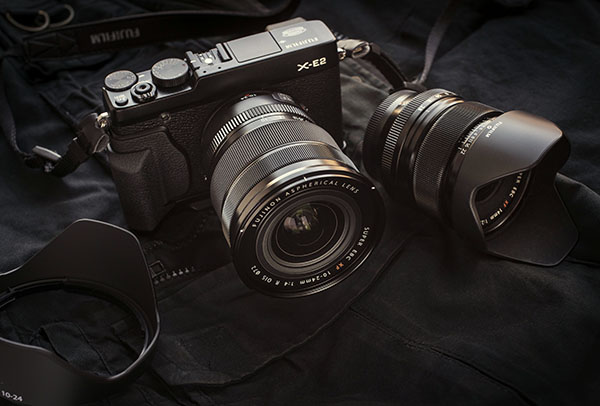 |
| The Fuji XF 10-24mm f/4 zoom lens mounted on an X-E2 with an XF 14mm f/2.8 lens next to it. |
The other thing I noticed with some of my first test shots was the absence of any vignetting -- very unusual, particularly for such a wide angle lens, and a zoom at that.
The 10-24mm is image stabilized, whereas the 14mm is not. Of course you are going to need at least one stop of image stabilization to make up for the difference between using f/4 and f/2.8 hand held in low light.
 |
| The 10-24mm zoom on the left compared to the 14mm f/2.8 on the right. There is a big difference in size and weight. |
At f/5.6 there is literally a jump in sharpness that is astounding. I'm used to lenses getting a bit better as the aperture is stopped down one stop at a time. With the Fuji 10-24mm them move from f/4 to f/5.6 produces a jump in sharpness that is absolutely astounding and will probably have all of us putting tape on our apertures to fix them to either f/5.6 or f/8.
You can tell from the test photo above that there is virtually no vignetting or rectilinear distortion. Achromatic distorting was almost non-existent also.
How does the 10-24mm zoom compare to a fixed focal length wide angle lens like the Fuji 14mm? In tests I did with the two lenses where the 10-24mm zoom was set to 14mm and f/4 it appears to deliver the same image sharpness right into the corners, as the 14mm lens at f/4, which is to say it is very sharp.
 |
| The Flatiron Building in NYC, one of my favorite test subjects for resolution because of the detailed mosaic work over the surface. Shot at f/4 at 15mm, it is tack sharp everywhere. Click here to download a high res version. |
 |
| Shot into the bright afternoon sun at 14mm and f/11 with the sun off towards the frame edge to cause maximum flaring. |
 |
| An intentionally blurred 19mm tunnel shot hand held at 1.2 sec and f/7.1 taken with the X-E2. |
 |
| Photographed at an ideal aperture of f/8 and 16mm focal length, it really doesn't get much better than this. Click here to download the high res file. |
 |
| Other side of the Washington Square monument into the sun at 16mm and f/8. |
 |
| A new art installation listing the names of 392,486 artists is located along the Hudson River. It is part of the Whitney 2014 Bienal, and titled "Artists Monument" by Tony Tasset. |
 |
| 10mm at f/16. Things don't get any sharper than this. |
Conclusion:
I went into this test expecting many of the typical disappointments associated with super-wide angle zoom lenses -- corner softness, rectilinear distortion, heavy vignetting. Instead I came away with even more respect for the folks at Fujifilm for making such an excellent lens with virtually none of the aberrations that usually plague this breed of zoom. This truly is one of the best super-wide angle zooms I have even used, and well worth its modest price of $999.99.
An aperture of f/4 may not be ideal, but with the added feature of image stabilization allowing you to hand hold it at one shutter speed lower than usual, you pretty much regain the stop anyway. Plus for the type of work a lens like this will usually do it will be often on a tripod and stopped down.
When compared to the Fuji 14mm fixed focal length lens, the 10-24mm seems quite large. It did not seem to feel that way, however, even though I was using it on the smaller X-E2 camera. The package of camera and lens was quite comfortably balanced.
I am not sure I would own both the 10-24mm zoom and the 14mm lens. One or the other should be sufficient to cover the range. Nonetheless, it is nice to have the choice as the Fuji lens lineup continues to expand, and it is also nice to be able to make the choice based on size, price, and comfort rather than upon quality. Both lenses are equally superb, and literally best of breed at what they deliver.
 |
| With the X-E2 in 16:9 crop mode, this photo of the Flatiron Building was taken at 19mm and an exposure of 4.5 seconds in order to create the blurred lights of passing traffic. |
If you are planning on purchasing this lens, you can
help support this site at no extra cost to you by purchasing from one of our
affiliate sellers listed below -- and thanks for your support.



Thanks for the review, but i have a question,
ReplyDeleteI thinking about sale my D700 (24-70, 16-35, 80-200 and 50 1.4 G) to get the X-T1 (10-24 and 56 1.2)
But I´m not sure which one to buy
10-24 F4 or 23 1.4 + 14 2.8
Can you give me any advice?
Regards,
In terms of optical quality I think you'll be happy either way. It really depends on whether or not you need the faster apertures of the 23 and 14. The 14 is only one stop difference, but the 23 is a three stop difference, which is quite a lot. Since you are now using the 16-35 on your Nikon, it means you are accustomed to f/4 which casts a vote for the Fuji 10-24. I use the 16-35 on my Nikons. I think the Fuji 10-24 delivers better results.
ReplyDeleteLater this year Fuji is coming out with f/2.8 zooms that will be similar to your Nikon 24-70 and 80-200. My guess is they will be taking 72mm filters, which would mean all of your filter sizes will be the same if you go with the 10-24.
I realize this is an old thread/article, but I have a question regarding these two lenses.
DeleteI'm in need of a wide angle zoom lens, and I'm considering the 16-35mm for my Nikon D600 or Fuji 10-24 for my X-T1. It is going to be used for landscapes.
Weight aside - what would you recommend for the best possible image quality?
I have both of those lenses and can say that the Fuji 10-24 is definitely the better lens. It's optical performance is more up to the standard of Nikon's best wide angle zoom, the 14-24mm, but with out the rectilinear distortion of the Nikon lens.
DeleteThanks. Exactly what I was hoping for :-) I'm reluctant to buy more big/expensive lenses for my DSLR as I see myself using the smaller camera more :-)
Deletei have the 14 and 23, both very fast, but sometimes the 14 could be wider. so am contemplating selling both and getting this. but… the f4… hmmm… i have read elsewhere that you can handhold the 10-24 at super slow shutter speeds. other than the tunnel shot, have you tried 1/2 second or longer handheld shots?
ReplyDeleteI'll give it a try with the slow shutter speeds tomorrow and let you know. - t
DeleteI got around to trying some hand held shots today down to 1/6sec, but mostly around 1/10th sec. I did the tests with and without the stabilizer turned on, and used the motor drive to avoid the camera shake that occurs the first time you press down on the shutter release. Excellent results. I was very surprised and quite pleased, especially because I purposely did not try too hard to steady myself.
DeleteThanks for the answer Tom, i´m going with the 10-24 + 56 1.2
ReplyDeleteI think you'll be happy with both of them. I just did an entire beauty shoot today using only the 56mm f/1.4. It will be the subject of tomorrow's blog post.
ReplyDeleteTom, if you could only have the 14mm or 10-24 which would you get? I'm primarily a portrait shooter.
ReplyDeleteHonestly, it depends upon how much you need the variety of focal lengths offered by the zoom, and whether or not you are willing to sacrifice one f/stop for them. Both lenses are really sharp and distortion free. So its a toss-up in that regard. Another option, if you want a single focal length but need to go a little wider, is the Zeiss Touit 12mm f/2.8.
DeleteHello Tom,
ReplyDeleteWhat kind of sharpening was applied to the first picture (either in camera or in post processing)? The image looks very oversharpened to me, which makes the out of focus area look pretty terrible to me.
Also, this lens had severe distortion at 15mm but this is ofcourse corrected in camera so you never notice it.
I very, very rarely use sharpening on any of my photos, and didn't use any at all on the photos in this post. - t
DeleteHmmmm. Wow. You are the only photographer that I know that doesn't sharpen images at least to a small degree. Interesting. Where do you get your cameras fine tuned?
DeleteCraig, there is a reason I shy away from sharpening my images. As a commercial photographer, most of my images end up in print. Printers do not like the image to be sharpened, especially over-sharpened. They prefer to do this themselves to suit the type of print run they are doing. So, for me, arriving at a sharp image is due more to practicing proper shooting technique and using equipment that can deliver the goods. That is why I perform all the equipment testing I write about here. For me, it isn't so much about fine tuning the cameras, it's more about getting the right camera and lens in the first place.
DeleteHey Tom, between the 10-24 and Zeiss Touit 12 2.8, which would you recommend? I'm leaning towards the fuji 10-24 as it gives 15mm on the X-E2 whereas the Zeiss would be 18mm, but the f2.8 and image quality of the Zeiss is very tempting.
ReplyDeleteKevin - This is a really good question, one that I have been asking myself recently. I did an entire blog post on the response. You can read it here:
ReplyDeletehttps://aboutphotography-tomgrill.blogspot.com/b/post-preview?token=CzSLsEYBAAA.3Et7uyt7uebgBZdJzBN1AA.tAWYx9G3xsZDQ6BjBmiDhQ&postId=5591791993006961548&type=POST
Hey Tom. I am looking for a wide angle lens. Fuji 14mm or 10-24? i already have the 23mm. Which one is the sharpest? Thank you!
ReplyDeleteNicolas, these are all sharp lenses. Primes are normally better than zooms, but Fuji has created an amazing zoom here. And don't forget the Zeiss Touit 12mm. It's also an amazing lens. I think you should choose based on other features. The primes (Fuji and Zeiss) are much smaller and easier to stuff into a crowded camera bag. The zoom is large, but has the convenience of multiple focal lengths -- something I don't find as important with super wide angles as I do with longer focal lengths. I solved myself the angst of deciding by buying both. I use the 14mm with I want to pack light (which is most of the time), and the zoom for when I want to have the versatility because I know I will be using mostly wide angle focal lengths. You won't go wrong with either choice.
ReplyDeletehi,
ReplyDeleteif is it possible i need full res images of xf 10-24 @10mm and @14mm f4-5.6-8 comparison so that both focal length give the same view i.e you have to adjust your position .i really need this comparison.hope fully in boh raw and jpeg
Dear Tom,
ReplyDeleteThank you for the great review. Just for the whole wide angle picture - I'm using the Samyang 12mm. f/2.0 manual focus lens with great happiness:)